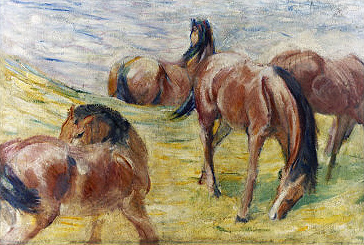Marc loved to paint horses, and they were the major theme of his career
He endeared to Pablo Picasso’s symbolism style and his way of transmitting what is real. And through his painting Horses Out To Pasture he captures all that is true and with the Impressionism skills he developed on the first trip to Paris he manages to simulate shifting light and colour to reflect light, with primary unmixed colours.
This colour saturated painting has a natural rhythm of which he achieved compassion with the poise but unpredictable nature of freedom. And Horse’s Out To Pasture could have been more about representing the inner soul of a life and that was something spiritual that he found in horses through his art.
His artistic principles became a mixture of Symbolism, Romanticism and Expressionism. He was fascinated by Vincent Van Gough’s work and the way he used paint and colours to symbolise emotions.
Franz Marc had a very religious upbringing and after his confirmation in 1894 he spent 4 years studying to become a priest. However he found religion to be restricting and afflicting to his mind and gave it all up to study philosophy in 1898. Another 2 years on in 1900 he changed again, this time to study art at the Munich Academy.
Marc was not happy with his decision to marry in Easter of 1907 and ran away to Paris before his wedding night. A previous trip to Paris had begun his awareness in Impressionism. He discovered the innocence of animals on his second trip there and became a master of animal anatomy and he taught the subject to earn money.
He sensed human beings were insignificant in contrast to nature where the simplest of things could be found in the mysteries of the environment. And he also assumed animals were superior in an uncontaminated world.




